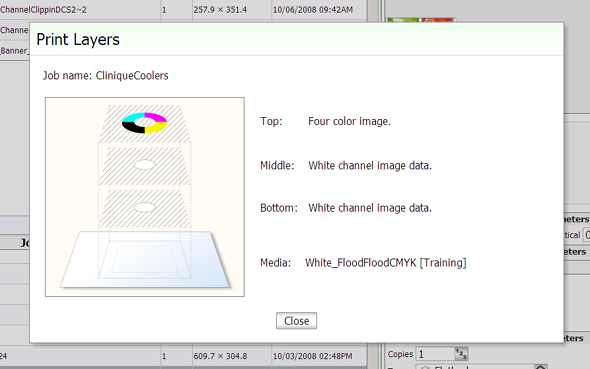

Océ Arizona printers with the White Ink Option provide under-printing for non-white media or objects, over-printing for backlit applications on transparent media and/or printing white as a spot color.
This section describes how the printer provides white ink support, gives a summary of the workflow data preparation, and also shows some of the ways white ink can be used in print applications.
When the white ink information is properly prepared according to the methods described in this chapter and the print job is sent from ProductionHouse to the printer, you have an opportunity to verify that the layers are properly embedded in the job.
With the white ink print job selected in the Job Control module of the printer software, click the Layers button to activate a graphical representation of the Print Layers that allows you to verify the layer order.
 Preview Layer in Printer UI
Preview Layer in Printer UI |
White layers can take two forms: Flood Fill layers and Spot Data layers.
A Flood Fill layer is like an autofill that is done by the printer, where white data fills the entire bounding box (the rectangular area that defines the total perimeter) of the image.
White Spot data can be defined in image editing applications such as Adobe Illustrator® or with the Spot Layer tool in Onyx ProductionHouse.
All of these methods to create white ink output will be explored and explained in this chapter.
White ink print job output can be accomplished in a variety of ways depending on the desired results and preferred working process. There are three primary methods and they can be used either independently or all at the same time. The workflow options are:
Flood Fill Layer Configuration,
ProductionHouse’s Spot Layer Tool, and
White Spot Data Image Preparation.
Flood Fill Layer Configuration in an Onyx Media Model does not require any pre-rip file preparation and is the easiest method of achieving white ink output. All that is required is to set up the Layer Configuration to include a flood layer. Spot data cannot be processed in this way, as functionality is limited to creating a flood layer, which encompasses the bounding box (the outer border of the image) of the file being processed.
ProductionHouse’s Spot Layer Tool offers many options to process an image, and thus allows various possible configuration choices. You can save these configurations as Filters and place them in a Quick Set and this makes it possible to re-create with minimal effort settings that are often used. All work with the ProductionHouse Spot Layer tool requires a media with spot layers enabled in the layer options in order for it to work as expected.
White Spot Data Image Preparation requires that the white data be prepared in image editing programs such as Adobe Illustrator® or PhotoShop®. You must use specific naming conventions and image use protocols in order for the Onyx RIP-Queue software to process the data as desired. This method may be the best choice if the desired white ink spot data includes complicated selections or if data is being created for outsourcing. A reasonable level of proficiency in these programs is recommended to use this technique.
All of these methods can also be used either alone or in conjunction with each other to create the desired output results. For example, you may generate the spot layer information for parts of an image in PhotoShop and then go on to specify a Flood Layer Configuration in Production House. This can result in a Flood Layer and a Spot Layer followed by a CMYK Layer. The spot data and the flood will occupy two layers of white density and the CMYK image data can occupy the third layer. You can determine the print order of these layers in ProductionHouse.
The following are some specific examples of the ways that the white ink workflow can be applied.
Backlit Application
The backlit application involves printing onto a transparent or translucent material and mounting the finished piece onto a light box or location where illumination from behind is possible. In the backlit application, white ink is intended to provide a light diffusing layer. This application is possible using either 2 or 3 layers.
Day-Night Application
Similar to backlit, the day-night application also involves printing onto a transparent or translucent material. A day-night print can be viewed either front-lit or backlit. This is achieved by printing color data on two separate layers with a white diffusing layer in the middle.
Opaque Application
The opaque application involves printing CMYK data onto non-white media. For this application, white ink is required both to enable the printer to produce images where white forms part of the image content, as well as to act as a base for the CMYK color set.
|
Application |
Bottom |
Middle |
Top |
Notes |
|---|---|---|---|---|
|
Backlit First Surface (printing on the front side of the media) |
White |
CMYK |
CMYK |
CMYK layers contain same data. |
|
Backlit Second Surface (printing on the back side of clear media) |
Reverse printed CMYK |
Reverse printed CMYK |
White |
|
|
Day-Night (First or Second surface) |
CMYK |
White |
CMYK |
CMYK data is printed reverse or right-reading |
|
Opaque |
White |
White |
CMYK |
3 layers |
|
Opaque |
<empty> |
White |
CMYK |
2 layers |